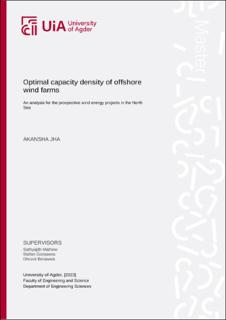| dc.description.abstract | The North Sea and Norwegian continental shelf have been identified to possess some of the world's best wind resources. Nine countries, including Norway, have signed the Ostend Declaration and established their offshore wind development targets for 2050. However, space constraints, current consumption, siting regulations, and spatial planning risks accentuate the need for finding an optimum design parameter, i.e., capacity density (MW/km2) for offshore wind farms. A thorough understanding of this optimization problem seems to be missing in the offshore wind energy industry including leading offshore wind developers. Achieving an optimal capacity density involves a collaborative effort while also considering the potential economic and environmental benefits of the project. This master’s thesis aims to create guidelines and identify the levers that drive the optimal capacity density of an offshore wind farm in the North Sea by assessing wind characteristics, evaluating net annual energy production, computing economic indices, and performing sensitivity analysis.
The work emphasizes better understanding of the input and output parameter sensitivities pertaining to techno-economic factors under eleven different scenarios using PyWake simulation and cross-linking the simulation results to create a sensitivity analysis tool for economic indices. The focus is on in-depth study to document the procedure involved in identifying the optimal windfarm capacity density and not simply objectifying the results based on the most accurate wake model.
The study found that different offshore wind developers may reach different optimum capacity densities depending on their assumptions, methodologies and technologies used for estimation and reporting the financial metrics. For example, the study shows that the choice of wake model can lead to a significantly different optimum capacity density between 4.76 and 9.10 MW/km2 with the motive to maximize profit using a conservative and optimistic approach. Moreover, some developers may have more advanced or sophisticated methods for wind farm simulation and power production estimation, leading to more accurate and precise capacity density estimates. Based on a comprehensive analysis of various parameters and their impact on sensitivity, the optimal capacity density is anticipated to lie between 3.62 and 6.05 MW/km2 for a typical wind farm located in the North Sea. In some extreme cases where wind resources are scarce or strike prices are below levelized energy cost, the optimal capacity density could be as low as 2.64 MW/km2. | |
